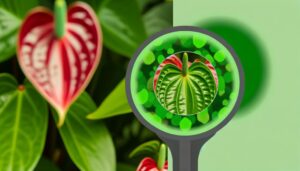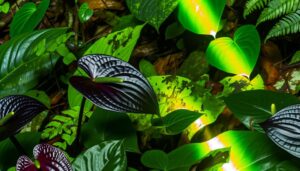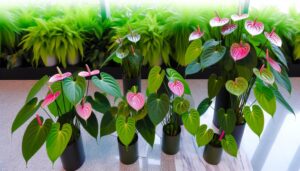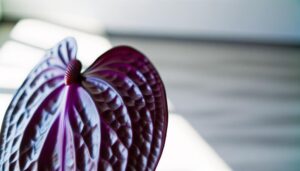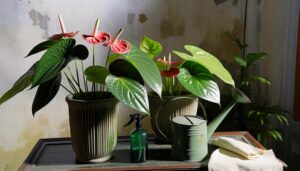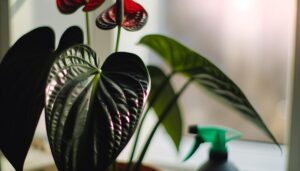Top 3 Benefits of the Red Anthurium Plant
You'll find the red Anthurium (Anthurium andraeanum) is a remarkable choice for its low-maintenance care, requiring only occasional watering when the top inch of soil dries and thriving in indirect, filtered light at temperatures between 65°F and 80°F. Its broad, waxy leaves filter out toxins like formaldehyde, ammonia, and xylene, notably enhancing indoor air quality.
Additionally, the vibrant red spathes and glossy, heart-shaped leaves stimulate sensory responses and trigger dopamine release, elevating mood and reducing stress. Curious about the deeper benefits and care tips?
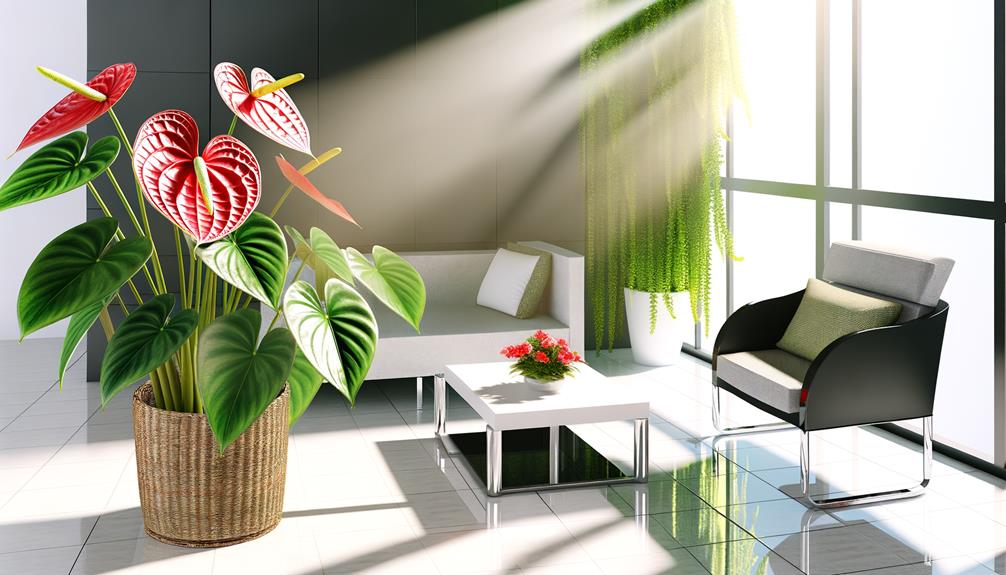
Key Takeaways
- Red Anthurium plants filter out formaldehyde, ammonia, and xylene, improving indoor air quality.
- The plant requires low-maintenance care, thriving with occasional watering and indirect sunlight.
- Its eye-catching red spathes and lush green leaves enhance visual and emotional comfort.
- Red Anthurium plants help reduce stress and boost mood by stimulating sensory responses.
- They absorb and neutralize harmful VOCs, collaborating with soil microbes to break down toxins.
Low-Maintenance Care
Caring for the red Anthurium (Anthurium andraeanum) is straightforward as it thrives with minimal attention, requiring only occasional watering and indirect sunlight to flourish.
Position your Anthurium in a location where it receives filtered light, avoiding direct sunlight that could scorch its spathes and foliage.
Water the plant when the top inch of the potting mix feels dry; overwatering can lead to root rot. Use a well-draining, peat-based soil mix to maintain ideal moisture levels.
Maintain indoor temperatures between 65°F and 80°F (18°C-27°C) and provide moderate humidity.
Feed your Anthurium monthly with a balanced, water-soluble fertilizer during the growing season to support its vibrant spathes and lush green leaves.
Follow these guidelines, and your Anthurium will thrive effortlessly.
Air-Purifying Abilities
Did you know that the red Anthurium (Anthurium andraeanum) also excels in improving indoor air quality by filtering out common pollutants such as formaldehyde, ammonia, and xylene?
This tropical plant uses its broad, waxy leaves to absorb these harmful volatile organic compounds (VOCs) through stomata, tiny pores on the leaf surface. The pollutants are then broken down and neutralized within the plant's cellular structure. Such a biological filtration process can notably reduce the concentration of these toxins in your living space.
Additionally, the red Anthurium's root system collaborates with beneficial soil microbes to further degrade these chemicals, ensuring a cleaner, healthier environment. By incorporating this plant into your home, you're not just adding beauty but also enhancing air quality.
Mood-Boosting Properties
Incorporating the red Anthurium (Anthurium andraeanum) into your living space can uplift your mood by stimulating sensory responses through its vibrant colors and unique floral structure. The vivid red spathes, scientifically known as modified leaves, surround the spadix—a columnar inflorescence—creating an eye-catching contrast. This visual stimulation can trigger the release of dopamine, enhancing your sense of well-being.
Additionally, the Anthurium's glossy, heart-shaped leaves, with their lush green tones, contribute to a tranquil atmosphere, reducing stress levels. The plant's ability to thrive in moderate light and humidity further ensures it remains a constant source of visual and emotional comfort. By engaging multiple sensory pathways, the red Anthurium becomes an integral part of your mood-enhancing environment.
Conclusion
You've discovered that the red anthurium (Anthurium andraeanum) isn't just beautiful—it's practical. It's low-maintenance, so you won't spend hours on care.
Its air-purifying abilities, backed by NASA studies, mean cleaner air for you.
Finally, its vibrant blooms elevate your mood, proven by psychological studies.
Embrace the anthurium; it's easy to care for, purifies your air, and boosts your mood, making it an essential addition to your indoor plant collection.

